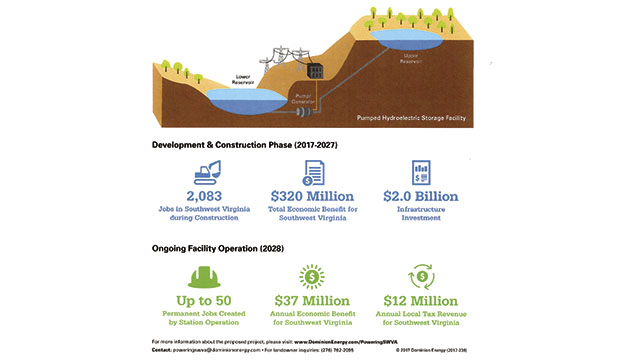Image courtesy Dominion Power
By Scott Robertson
Dominion Power officials met with residents in Big Stone Gap and Tazewell, Va., Oct. 3 and 4 to share the company’s vision for pumped hydroelectric power stations in one or both communities. The idea of using abandoned coal mines as sites for hydroelectric facilities has been gaining steam this year, with support from the governor, the House of Delegates and the Senate.
The basic concept involves a pumped hydrostorage facility in which Dominion would build an upper reservoir and a lower reservoir at elevations with a difference of 1,500 feet or more. That allows sufficient capacity, when water is released from the upper reservoir to the lower reservoir, to spin turbines that produce electricity for the power grid. Water from abandoned coal mines is seen as a potential supply for such facilities, with one potential site even using a mine as its lower reservoir.
“We have looked at seven counties,” said Spencer Adkins, director of Generation Construction. “At one point, we had nearly 150 preliminary sites that we considered.
“We filed a permit application with the Federal Energy Regulatory Commission on Sept. 6 for the Tazewell site. The reservoirs and the conduit for our water on that site encompasses around 4,100 acres. Dominion owns around 2,600 acres of that. We’re in the process of determining how much water we can get to that site, looking for geological concerns – we’re just now starting that process.”
At the same time, Dominion is looking at the Bullitt Mine in Wise County. “We did not file an application on that site yet,” Adkins said. “Right now, that’s more of a concept than an actual site at this point.” Dominion is working with Virginia Tech on a feasibility study for using a coal mine such as Bullitt as a lower reservoir. The company expects that study to generate findings within eight months.
But even if the mine itself isn’t used as a reservoir, Adkins said, water from mines will likely play a key role. “Even though the lower reservoir in Tazewell is not in a mine, we are looking at water from a nearby mine as a source for that site,” Adkins said. “That mine is about eight miles west of the site. We’re looking at pipelining it into the reservoir.”
“We’re looking at records from the Virginia Department of Mines, Minerals and Energy as to how much water is in the Bullitt Mine. They have those records. So Virginia Tech is looking at what kind of effect it would have on the mine if we were to take that water out and cycle it back and forth. That’s part of the feasibility study.”
Pumped storage plants work by using cheap, excess electricity at night to pump water uphill into the upper reservoir. Energy can be recaptured during times of higher demand by reversing the flow and sending the water through turbines to the lower reservoir. Dominion is pushing the plan as a way to backfill supply when alternative sources like solar and wind are in down periods.
“There’s a lot of solar coming onto the grid now, a lot of renewables,” Adkins said. “That will be a part of this project. We don’t know what that looks like yet. Sometimes with solar, when it’s cloudy, you don’t have any power production. So if you use a lot of solar it can cause swings on the grid. A facility like this can help level that. This site acts as a huge battery.
“We would normally reduce that water to generate when demand is greatest and power prices are higher,” Adkins said. “We would try to pump that water back up when demand is lowest and power prices are lower.”
In the meantime, Dominion is looking for public support for the project, promising big economic benefits for Southwest Virginia. “It could be a $3 billion expenditure,” Adkins said. “It could be $1 billion. We don’t know, but we picked $2 billion based on high-level estimates. We would use approximately 2,000 construction workers for a period of five to seven years. So that will have a positive effect on hotels, restaurants and all the other amenities in those areas.
“Once it’s up and operating, based on that $2 billion model we estimate an economic impact of around $12 million on personal property taxes, and we think we’ll hire up to 50 permanent employees to work at the site,” Adkins said. “We’re very excited about the project.”




